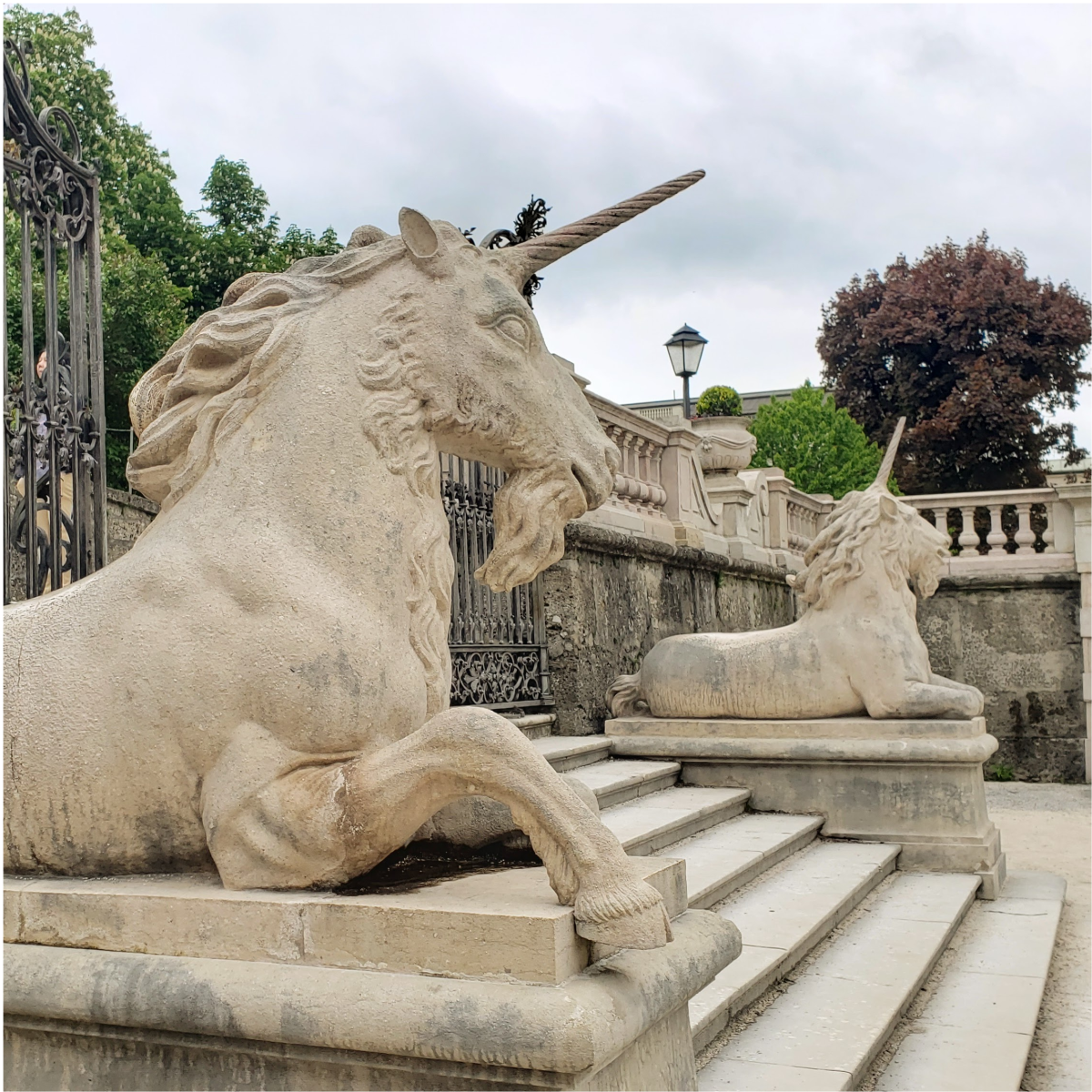I had originally planned to explore the subject of unicorns as a way to discuss a piece of medieval art that I’m very fond of. However, once I began digging into the research for it, I discovered that what I wanted to share with you would be too much for this month’s post. (It was like opening a can of unicorns!) So I have decided on a two-month unicorn theme. This month we’ll examine the legend of the unicorn in general. That way, we’ll be better able to appreciate the art we’ll look at next month.
Unicorns have a long history and a layered mythology. Ctesias, a Greek physician and historian who lived around 400 BCE, first documents the unicorn in his book, Indica. He describes them to be wild asses the size of horses, with white bodies, red heads, blue eyes, and a single horn extending from their forehead. The horn was multi-colored as well, with a white base, black middle section, and crimson tip. He further explains that they were powerful and fast animals, hunted not for their flesh (which apparently was very bitter), but rather for their horn, as drinking from the horn could make you “immune even to poisons.”
Tales and descriptions of the unicorn continued to be written down by Greek and Roman writers. Aristotle wrote of oryxes and asses that had a single horn. Pliny the Elder, a Roman writer in the field of natural history, also mentions animals with one horn. Pliny goes a step further and gives one of these animals the name monoceros, thus bestowing the unicorn with its own name and existence (as opposed to being a species of ass with a single horn).
The Unicorn as a Christian Symbol
The legend of the unicorn passed down through generations and eventually found its way into the Bible. For example, a passage from the King James translation of the Bible reads, “Will the unicorn be willing to serve thee, or abide by thy crib? Canst thou bind the unicorn with his band in the furrow? Or will he harrow the valleys after thee? Wilt thou trust him, because his strength is great?” (Job 39:9-11).
In her book, The Unicorn Tapestries, Margaret B. Freeman explains how the unicorn continued to gain acceptance as a Christian symbol:
Throughout the Middle Ages, passages from the Bible [like the one above] … were cited by theologians, encyclopedists, and tellers of popular animal tales as references concerning the unicorn. At least as early as the third century the unicorn was adopted by the Christian world, not merely as a remarkable animal that had been described by pagan writers and endorsed by the Bible, but as a symbol of Christ.
Freeman also gives us a specific example, which is related to the passage from Job mentioned above. She describes the way in which Saint Basil, bishop of Caesarea during the 4th century, extends the symbolism of the unicorn as a representation of Christ. She writes, “… [Saint Basil] says in part that Christ ‘will be called the Son of unicorns, for as we have learned in Job, the unicorn is irresistible in might and unsubjected to man.’” This type of interpretation encouraged the acceptance of the unicorn as a Christian symbol.
Unicorns Appear in the Physiologus
Yet, the Bible was not the only source lending veracity to unicorns during the Middle Ages. At some point during the second and fourth centuries, an anonymous author produced a book known as the Physiologus. The book is a collection of descriptions and legends of both real and mythological animals, including the unicorn. Barbara Drake Boehm, in The Metropolitan Museum of Art Bulletin entitled A Blessing of Unicorns: The Paris and Cloisters Tapestries, further elaborates on the Physiologus:
The Physiologus—compiled and penned in Greek by a Christian, for a Christian audience, and then translated into Latin in the fifth century—specified that the unicorn has the beard and cloven hooves of a goat, and, furthermore, that it could only be tamed by a maiden.
The Physiologus was popular reading during the Middle Ages, and as centuries passed, it grew to include more animals. In time these larger versions spread across Western Europe and were known as bestiaries. Boehm further reveals that in addition to textual “evidence” about the existence of unicorns, there also existed more tangible proof. She explains:
Beautiful spiraling horns associated with the beast had been kept in the treasury of Saint-Denis in Paris since the time of Abbot Suger (1081–1151), gifts from King David I of Scotland. The church of San Marco, Venice, boasted three horns, two of which bore Greek inscriptions; and one of the two was also inscribed in Arabic! In England, the royal treasury of Westminster Abbey was home to just one of the highly coveted unicorn horns; ….
Such horns, recognized today as the tooth of the narwhal, were also incorporated into precious princely possessions.
The Unicorn’s Magical Horn
As proof of its existence or as a precious prize, the unicorn’s horn seemed to be one of the most valued and magical aspects of the animal. The belief that the horn was able to absorb poison contributed to its importance. Margaret B. Freeman, in The Unicorn Tapestries, provides a quote from a late Greek version of the Physiologus, which describes how a unicorn purifies a lake where many animals gather to drink from:
But before they [the animals, I believe] are assembled the serpent comes and casts its poison into the water. Now the animals mark well the poison and do not dare to drink and they wait for the unicorn. It comes and immediately goes into the lake and making with his horn the sign of the cross renders the power of the poison harmless. And all the other animals drink as well.
The story operates on two levels: it explains the horn’s role in the legend of the unicorn, but it also includes Christian symbolism with the serpent representing the devil and the unicorn as Christ. The horn, however, was not the only valued part of the unicorn. Saint Hildegard of Bingen recommended using a mixture of the powdered liver of the unicorn and egg yolks to cure leprosy. She also noted that wearing a belt made from unicorn hide at the waist and against the skin could “… preserve one from the dangers of pestilence and of fevers.”
Capturing a Unicorn
The enticing draw of the magical powers of the unicorn led to a powerful theme that runs through much art and romantic writing of the Middle Ages: the hunt and capture of the unicorn. The Physiologus and the bestiaries that evolved from it also include the details for capturing a unicorn. Barbara Drake Boehm, in A Blessing of Unicorns: The Paris and Cloisters Tapestries, quotes from the text of Bestiary:
But it [a unicorn] can be caught in the following fashion: a girl who is a virgin is led to the place where it dwells, and is left there alone in the forest. As soon as the unicorn sees her, it leaps into her lap and embraces her, and goes to sleep there; then the hunters capture it and display it in the king’s palace.
Boehm also brings up an important question that is ambiguous in the text—once the unicorn is captured, is it slain for the prize of its horn, or is the unicorn kept alive and put on display at the palace? (I’m rooting for the latter. Or better yet, let the unicorn run free!) This seems like a good place to pause and ponder on the legend of the unicorn. Next month, we’ll take what we’ve learned here and apply it to better understand a piece of unicorn art created during the Middle Ages.
Photo credit: photo of unicorn statues at Mirabell Gardens by Steph Rae Moran, 2023, personal collection




